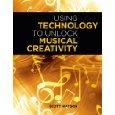 In Using Technology To Unlock Musical Creativity, Scott Watson puts forth a wealth of information, lesson plans, and innovative ideas intended to get music teachers thinking of new and creative ways to use the technology they have at their disposal to increase the creative opportunities that they provide to their students. The book is intended for use mainly by general music teachers, music theory, and elective music teachers, and the various projects found in Part 2 of the book are adaptable to all grades from elementary through high school.
In Using Technology To Unlock Musical Creativity, Scott Watson puts forth a wealth of information, lesson plans, and innovative ideas intended to get music teachers thinking of new and creative ways to use the technology they have at their disposal to increase the creative opportunities that they provide to their students. The book is intended for use mainly by general music teachers, music theory, and elective music teachers, and the various projects found in Part 2 of the book are adaptable to all grades from elementary through high school.
Using Technology To Unlock Musical Creativity- Part 1
In part 1 of the book Watson points out the rationale for why using technology is a natural way to bring out student creativity and how creativity will, in the future, offer workers and businesses a competitive advantage over other companies. In other words, the projects in this book are not just intended to help young musicians become better at their craft, but also to help other non-musicians open their minds to new, creative ideas and ways of looking at problems. This section begins with suggestions on how important it is to start any such project with compelling examples that are fairly easy to imitate and build from such as taking well known classical tunes and modernizing them simply by adding drum beat rhythms and other sound loops to the existing melodies.
Part 1 later goes on to examine the many different kinds of technology that help to remove limitations on creativity, things like modern music notation programs, looping sequencers, and other kinds of both hardware and software based music devices. It concludes with a section of suggestions on things to avoid when planning any such project and also examples of releases used to allow student work to be featured in an online presentation of some kind.
Lessons and Projects To Unlock Musical Creativity- Part 2
Part 2 of Using Technology To Unlock Musical Creativity features a series of chapters dealing with different ways to use technology and includes the necessary background information that a teacher might find useful in preparing their lessons. Each chapter is accompanied by a set of sample projects that can be adapted to use a variety of different tools and at a variety of different age levels. The book concludes with a summary section of how to wrap all of this up into a cohesive music education curriculum using one of three different methods from simple projects added into a class to fully a fully integrated class curriculum that forms the basis for the entire term.
Scott Watson’s innovative spirit and forward thinking attitude toward the use of technology in music education is refreshing and inspiring. Like almost most every other aspect of education, technology will continue to grow in its use both in and out of our music education classrooms. The creative and technical skills that students learn through these projects are part and parcel to the skills that they will need to be productive members of our society, even if their chosen career path is something other than one focused on music.
Scott Watson’s innovative spirit and forward thinking attitude toward the use of technology in music education is refreshing and inspiring. Like almost most every other aspect of education, technology will continue to grow in its use both in and out of our music education classrooms. The creative and technical skills that students learn through these projects are part and parcel to the skills that they will need to be productive members of our society, even if their chosen career path is something other than one focused on music.
This book is available both in paperback and as a Kindle eBook.